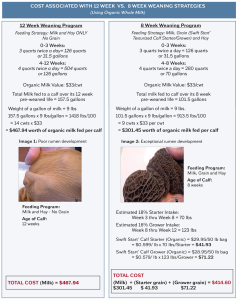The Case Of The Costly Calves
Click here to view as a pdf: The Case Of The Costly Calves
By Julie Wadzinski, B.S.
Production agriculture can be a costly venture, but there are methods and strategies that can be implemented to help assure profitability. For the dairy farmer, having a barn full of healthy and efficient cows is one of the best assurances for a positive economic outcome. The making of those profitable and healthy cows starts with 1) good colostrum management and 2) using a cost effective feeding strategy that will promote rumen development and proper frame growth.
Colostrum Management
Numerous studies have been done on colostrum feeding and its impact not only on calf performance, but future milk production as well. Making sure every calf gets a gallon of high quality (23% Brix or higher when tested with a digital refractometer) colostrum within the first 4 hours after birth, is the first step to maximizing your calf’s potential. Each calf should receive a minimum of 200 grams of antibody from the colostrum for optimum performance. The maternal antibodies passed to a heifer calf through the colostrum will not only help in preventing disease during calfhood, but will also positively impact her milk production well into her second lactation. One study showed an increase in milk production of 1,843 pounds during the first lactation for calves that received at least 200 grams of antibody over calves that did not receive the proper quality, or quantity, of colostrum. Another study showed that calves who did not receive enough maternal antibodies had a 50% reduction in feed efficiency during pre-weaning. Conversely, a calf that gets 200 grams of IgG will not only have better feed efficiency, but will also have a higher average daily gain. It was also found that heifer calves receiving 200 grams of antibody had significantly increased milk production for the first, second and third lactation as well as an 11% greater chance of surviving in the herd past their first lactation.
Cost Effective Calf Feeding Strategies
- Studies show feeding a gallon of milk or milk replacer per feeding results in an increased milk production of 2,261 pounds (combined 1st and 2nd lactations) over calves that were fed 2 quarts per feeding twice a day.
- Two products that can give your calves an advantage are Calf Milk Mate™, which fortifies the milk with the crucial nutrients Vitamins A, D & E and Selenium, and Calf Shield® that provides much needed immune support.
- It is important to feed a quality starter and grower grain at the right time to properly develop the calf’s rumen. The first step is to introduce a grain, like Crystal Creek® Swift Start® Texturized Calf Starter, at 3 weeks of age, and hay at 6 weeks of age. Following this time line will support better rumen tissue development for a calf that is ready for weaning at 8 weeks of age.
- The image below illustrates a Penn State research trial which evaluated the effects of calf starter on ruminal development in preweaned calves. The left hand column shows a calf that received only milk and hay for 12 weeks. Notice how undeveloped the rumen is. This calf is not ready to digest forage efficiently. Now consider the right hand column which shows excellent ruminal papilla development in an 8 week old calf that was fed milk, calf starter and hay. The right hand column represents a rumen that is ready to digest forage efficiently.
A good feeding program is the best insurance for raising feed efficient, profitable replacement heifers. Proper colostrum management, feeding an increased volume of milk, adding Calf Milk Mate™ and/or Calf Shield® to the milk and introducing Swift Start® Texturized Calf Starter will result in a money saving strategy with a calf that is ready for weaning at 8 weeks. Call today to get started on the Swift Start® Calf Program and solve your case of the costly calves.
Click on the image below to see a breakdown of feed costs associated with 12 week and 8 week weaning strategies on organic whole milk.

